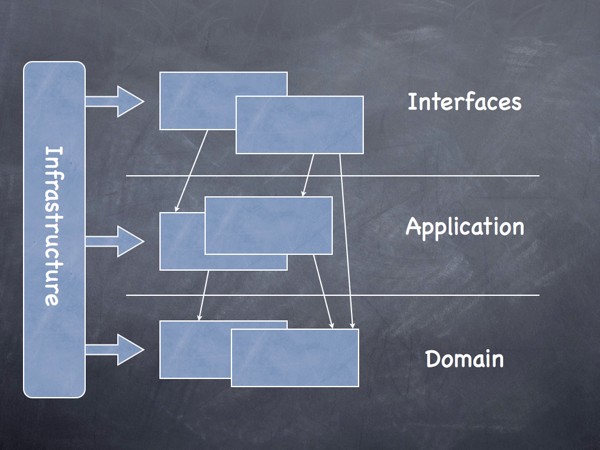Layers/Architecture
The Cargo Tracker application is layered as illustrated by this picture:

(Image credited to http://dddsample.sourceforge.net/)
As you can see, there are three vertical layers: Interfaces, Application and Domain, each supported by different kinds of Infrastructure. In the application, the package naming reflects these layers.
Interfaces
This layer holds everything that interacts with other systems (including humans :-)), such as REST/SOAP web services, WebSocket endpoints, web UIs, external messaging end-points and batch processes. It handles interpretation, input validation and translation of incoming data. It also handles serialization of outgoing data, such as HTML, JSON or XML across HTTP to web browsers or web service clients, or DTO classes and distributed facade interfaces for remote clients.
The net.java.cargotracker.interfaces package holds all the interface classes for the application. We have two Web UI interfaces - one for booking and other for tracking as well one REST interface and one scheduled file processor for reporting handling events. The REST interface is used by an HTML5/JavaScript client that targets mobile devices. The web interfaces are written in HTML5/JavaScript/JSF, the REST interface uses JAX-RS while the file processor uses EJB @Scheduled. Modern web application frameworks naturally enforce MVC style separation of concerns, so there is not that much heavy lifting you will need to do. In addition, you can enforce a façade layer if necessary (e.g. your UI team is sufficiently separated from the application services team or you wish to remain strictly agnostic of the UI layer). Otherwise, you can use simple adapters to adapt domain classes to your UI view. We demonstrate both techniques in the application.
Other than JSF, JAX-RS and EJB, other Java EE technologies typically used in the interface layer are Bean Validation, JSON-P (for serialization), WebSocket, JAX-WS (for SOAP web services) and JBatch.
Application
The application layer is responsible for driving the workflow of the application, matching the business use cases at hand. These operations are interface-independent and can be both synchronous or asynchronous. This layer is well suited for spanning transactions, high-level logging and security.
Note, the application layer is very thin in terms of domain logic - it merely coordinates the domain layer objects to perform the actual work. This is very different from traditional tiered architectures that tend to look more procedural with a lot of business logic in the application layer.
The net.java.cargotracker.application package contains all the application classes. The application layer is typically implemented using EJBs or CDI beans. Other Java EE APIs likely to be used in this layer are interceptors, JTA (in very rare situations where you would like to manage transactions yourself) and Java EE Concurrency.
Domain
The domain layer is the heart of the software, and this is where the interesting stuff happens. There is one package per aggregate and to each aggregate belongs entities, value objects, domain events, a repository interface and sometimes factories (see the Characterization page for details). The aggregate roots are Cargo, HandlingEvent, Location and Voyage.
The core of the business logic, such as determining whether a handling event should be registered and how the delivery of a cargo is affected by handling, belongs here. The structure and naming of aggregates, classes and methods in the domain layer should follow the real world as closely as possible, and you should be able to explain to a business domain expert how this part of the software works by drawing a few simple diagrams and using the actual class and method names of the source code. Note that it is not uncommon for some domain classes to simply model data and not contain any business logic.
The domain layer is usually implemented primarily using JPA and CDI.
Infrastructure
In addition to the three vertical layers, there is also the infrastructure. As the picture shows, it supports all of the three layers in different ways, sometimes facilitating communication between the layers. In the most common case the infrastructure layer consists of Repository implementations interacting with a database. In simple terms, the infrastructure consists of everything that exists independently of our application: external/third-party resources, persistence/database engines, messaging backends, legacy systems, and so on.
All of the infrastructure classes are in the net.java.cargotracker.infrastructure package. We use CDI, JPA, JMS and the JAX-RS client API in this layer. The typical application will mostly have JPA EntityManager code in this layer encapsulated with thin CDI bean Repository classes. Other Java EE APIs commonly used in this layer includes EJB clients, WebSocket clients and JAX-WS clients.